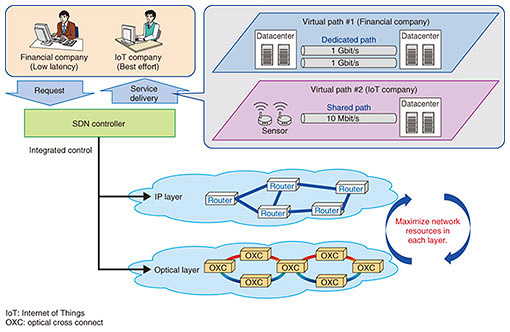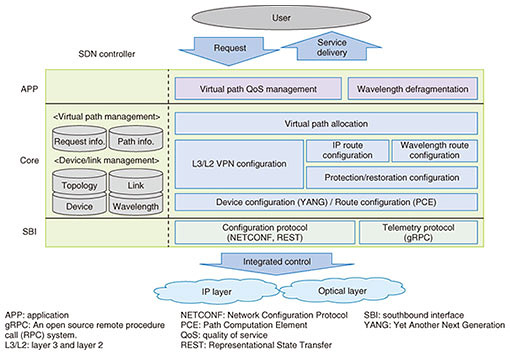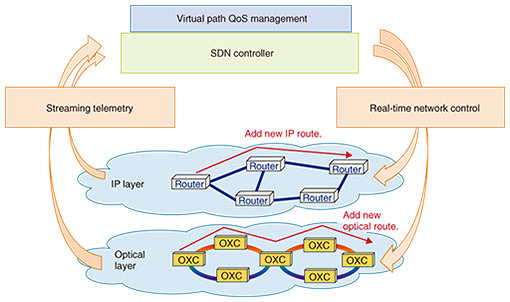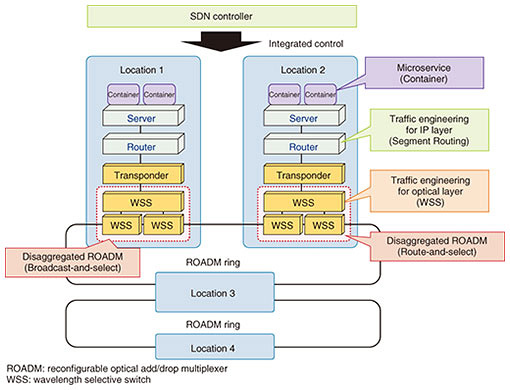 |
|||||||||||||||
|
|
|||||||||||||||
|
Regular Articles Vol. 16, No. 8, pp. 62–67, Aug. 2018. https://doi.org/10.53829/ntr201808ra2 Multi-layer SDN Control TechnologyAbstractTo cope with the transition of fixed and mobile networks to fifth-generation services and the further spread of cloud services, NTT Network Technology Laboratories is developing multi-layer software-defined networking (SDN) control technology to achieve integrated control of the IP (Internet protocol) and optical layers, on-demand support, and automatic network operations. In this article, we provide an overview of multi-layer SDN control technology and describe a technical verification test. Keywords: multi-layer SDN, telemetry, automatic control 1. IntroductionThe modern telecom network consists mainly of two types of layers: the optical layer for interconnecting datacenters via optical fiber, and the Internet protocol (IP) layer that performs packet transfer control. The optical layer and IP layer differ in their lead times for facility construction and the technologies that they use, so the conventional approach has been to design each layer independently and optimize the operation and management of each. From here on, however, the migration of the mobile network to fifth-generation (5G) and the further spread of cloud services are expected to create an environment in which diverse services exploiting the high-speed and low-delay characteristics of 5G can be provided, and services can be flexibly rolled out on the cloud as needed by users. For telecom networks, meanwhile, it is becoming increasingly necessary to provide on-demand communications between users and the cloud and between users themselves. Additionally, a network with high on-demand characteristics features highly dynamic traffic volumes and a tendency for traffic imbalances to occur in specific network intervals. There is therefore a need for a mechanism that can calculate the amount of free circuits and other resources throughout the network and allocate the resources needed, and a mechanism that can eliminate traffic imbalances through traffic routing control. To cope with this spread of 5G mobile communications and cloud services, we are developing multi-layer software-defined networking (SDN) control technology for performing integrated control of the optical layer and IP layer, which have traditionally been optimized separately, providing on-demand support, and automating network operations. 2. Multi-layer SDN control technologyMulti-layer SDN control technology performs integrated control of the optical layer and IP layer from an SDN controller to provide service-dependent paths such as IP-VPNs (virtual private networks) or Ethernet leased lines in an on-demand manner according to the user’s service request (Fig. 1). Another aim of this technology is to use each layer’s resources to the maximum extent possible by performing packet routing control on the IP layer and optical-wavelength routing control on the optical layer and keeping the network in an optimal state. To this end, NTT Network Technology Laboratories is implementing the functions shown in Fig. 2 based on the Open Network Operating System (ONOS) [1], an open-source SDN controller, and working to establish multi-layer SDN control technology.
2.1 On-demand virtual path allocationThe allocation of an on-demand virtual path is achieved by implementing (1) a function for configuring L3/L2 (layer 3 and layer 2) VPNs on routers, (2) functions for calculating IP routes and wavelength routes, (3) a function for configuring protection and restoration to provide virtual path redundancy, (4) a function for configuring devices, and (5) a device configuration protocol. In addition, on-demand virtual path provision does not simply provide circuits such as IP-VPNs or Ethernet leased lines—it also enables selection of multiple grades of redundancy to deal with faults. In this regard, the conventional approach to configuring redundancy was to adopt a single system for each network, as shown in Fig. 3.
However, network design using multi-layer control technology makes it possible for these two types of redundancy systems—IP protection*1 and optical restoration*2—to coexist on a single physical network and for any redundant configuration to be selected for every virtual path. IP protection features path duplication on both the IP layer and optical layer and achieves high-speed switching, which means high reliability but at a high cost. Optical restoration, meanwhile, provides path duplication on only the optical layer and has relatively slow switching, but it can provide redundancy at a lower cost compared with IP protection. By taking into consideration how redundancy affects cost in this way, the user may select a virtual path with the most appropriate redundant configuration according to service requirements and cost factors. 2.2 Real-time monitoring and control of network conditionsReal-time monitoring and control of network conditions is achieved by (1) functions for virtual-path quality management and routing control, (2) a function for wavelength defragmentation, and (3) a telemetry protocol. The SDN controller uses a streaming telemetry*3 protocol (gRPC etc.) to receive data from devices on the IP layer and the optical layer and to therefore determine real-time network conditions such as traffic levels, delay times, packet loss ratio, and optical wavelengths in use. The functions for virtual-path quality management and routing control detect deterioration in network quality (congestion, increase in delay time, etc.) from the data obtained and autonomously perform virtual-path routing changes without operator assistance to restore quality (Fig. 4). In a network that provides paths on demand, it is assumed that the state of the network can suddenly change, but incorporating such autonomous control is expected to enable flexible response to changes that cannot be handled by manual operations.
Next, the wavelength defragmentation function detects the fragmentation state of optical wavelengths from data on the wavelengths currently in use and changes the wavelength bands in use to other wavelength bands to perform wavelength rearrangement (defragmentation). Changing the optical wavelength bands momentarily disrupts communications, so multi-layer SDN control can be used to set the destination optical wavelength beforehand on the optical layer and perform high-speed switching on the IP layer to minimize this break in communications.
3. Technical verificationWe performed a technical verification test to assess the feasibility of multi-layer SDN control. We constructed a network with the configuration shown in Fig. 5, and in the test, we allocated virtual paths on demand and monitored and controlled network conditions in real time from the SDN controller. We performed routing control on the IP layer using Segment Routing and achieved IP-VPNs by applying MPLS (Multiprotocol Label Switching) above this routing. We performed routing control on the optical layer by controlling transponders and optical switches separately from the SDN controller and provided Ethernet leased lines by opening up optical wavelengths between target locations. The SDN controller was equipped with a management function for a disaggregation-type reconfigurable optical add/drop multiplexer (ROADM) to combine and operate multiple optical switches as a ROADM, and for this test, it was also equipped with management functions for broadcast-and-select*4 and route-and-select*5 types of ROADM architecture [2].
Redundancy was achieved through IP protection and optical restoration, in the former by performing high-speed switching at the time of a fault using loop-free alternate Segment Routing, and in the latter by controlling optical switches from the SDN controller to make an optical-wavelength detour on detecting a fault on an optical link. With these mechanisms, we confirmed that IP-VPNs or Ethernet leased lines could be provided between target locations from the SDN controller and that either IP protection or optical restoration could be selected to achieve redundancy. Next, in real-time monitoring and control of the network, we confirmed that traffic levels, delay times, and packet loss ratios could be obtained in real time using the gRPC streaming-telemetry protocol, and that the SDN controller could autonomously change the routing of virtual paths and restore quality when it detected quality deterioration below a certain level. Finally, in wavelength defragmentation, we confirmed that the optical waveform band in use could be changed while minimizing disruption to communications by establishing the destination wavelength beforehand based on the make-before-break idea and switching routing to a new wavelength path by Segment Routing. We also performed a test focused on orchestration. We constructed an environment that provided services by container location 1 and location 2 and implemented a scale-out mechanism for increasing the number of containers at either location to keep up with an increase in the number of service users as a container orchestrator. Additionally, in the same environment, in the event that the number of users increased to a point that the resources needed for providing a service by container at location 1 became insufficient, we also achieved a scale-out mechanism spanning two datacenters by having the SDN controller coordinate with an orchestrator to establish a new virtual path at location 2 so as to provide the service by container at location 2 as well. This mechanism achieves rapid service scale out across datacenters using light containers in response to a sudden increase in demand for a service and establishes new network paths needed by a datacenter from the optical layer to the IP layer on demand. These capabilities make it possible to provide network services that are economical and robust to change.
4. ConclusionWe plan to use the results of the technical verification test that we conducted on multi-layer SDN control technology to continue our research and development efforts in establishing essential infrastructure technologies for the IP and optical layers to support networks in the 5G era. References
Trademark notesAll brand names, product names, and company names that appear in this article are trademarks or registered trademarks of their respective owners. |
|||||||||||||||









